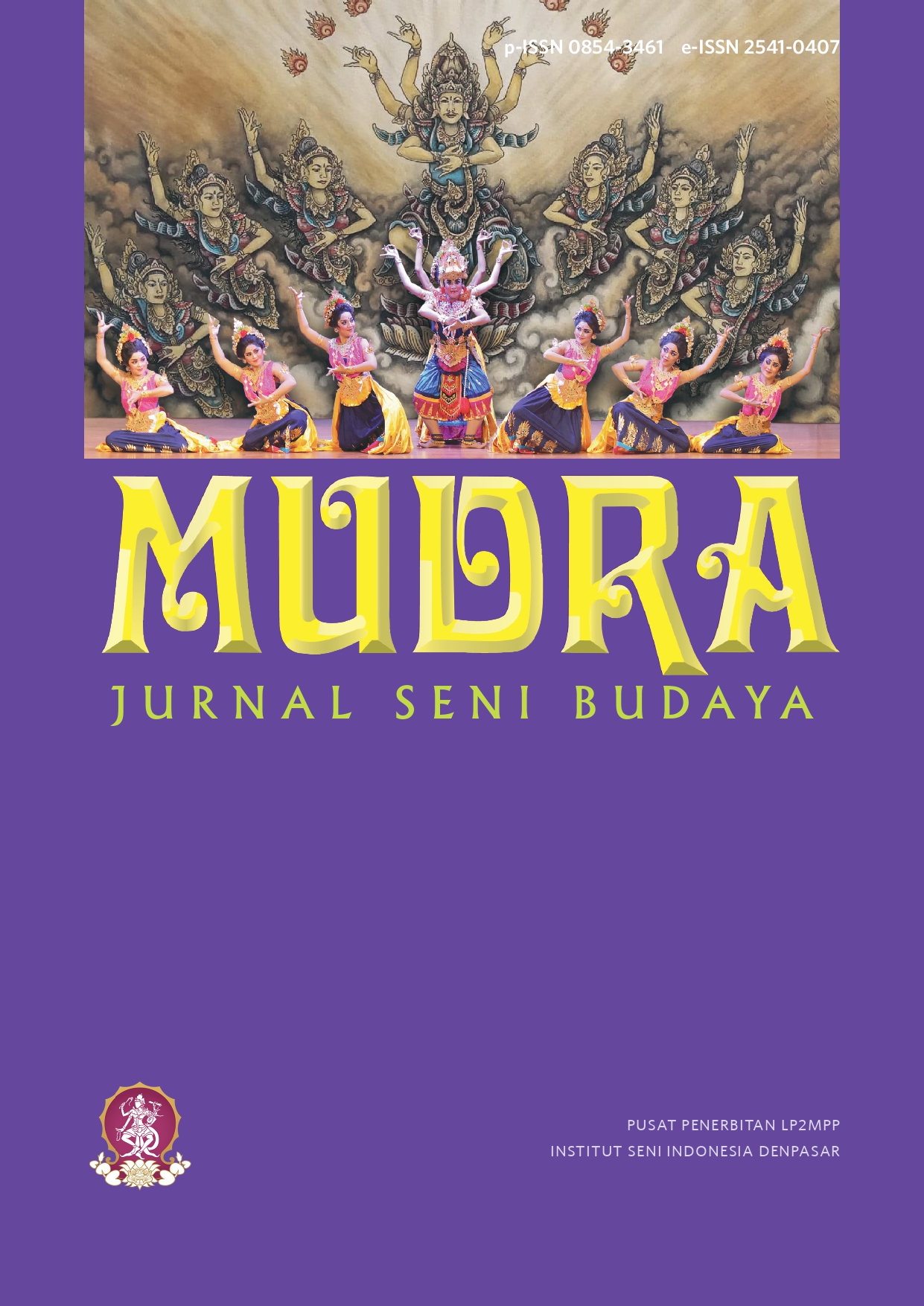Jangkang Baris Dance in Sidatapa Village Study on The Meaning And Potential as Tourist Attraction
DOI:
https://doi.org/10.31091/mudra.v38i3.2370Keywords:
dance, meaning, tourism potentialAbstract
This study aims to determine the meaning and potential as a tourist attraction for the Baris Jangkang Dance in Sidatapa village. This dance is very distinctive with the Balinese Aga culture which is different from Balinese culture in general. This research is qualitative in nature starting with determining the location in Sidatapa village. Collecting data using in-depth interviews, observation, and document studies. The results were analyzed using interactive analysis. The results showed that the Baris Jangkang Dance in Sidatapa village was popularly known as the Jangkang dance or war dance. This dance is used as a representation of the warrior spirit of the Sidatapa community in dealing with enemies who disturb the peace of the village. Baris Jangkang dance dancers are divided into two types of dancers, namely truna dancers (never dance) and surudan dancers (already dancing). Its position is divided into prabangsa (leader) and prawira (troop). The first potential could be watching dance and drum practice. The second is by watching live during the show. Third, selling various documentations of the Baris Jangka dance in various forms, such as VCDs, photos, clothes and as souvenirs for Sidatapa.
Downloads
References
Bandem, I Made dan F. Eugene deBoer. (2014). Kaja dan Kelod Tarian Bali dalam Transisi. (I Made Marlowe M.B penerjemah). Yogyakarta: ISI Yogyakarta
Caneen, Jeffery M. (2014). Tourism and Cultural Identity: The Case of the Polynesian Cultural Center. Athens Journal of Tourism. Vol. 1 No.2 Page 101-120. June 2014 https://www.atiner.gr/journals/tourism/2014-1-2-1-Caneen.pdf
Dibia, I Wayan. (2012). Geliat Seni Pertunjukan Bali. Denpasar: Arti Foundation Kata Hati. (penerjemah: I Wayan Dibia). Jakarta: Ford Foundation.
Kringelbach, H., & Skinner, J. (Eds.). (2014). Dancing Cultures: Globalization, Tourism and Identity in the Anthropology of Dance. Berghahn Books. Retrieved from https://www.jstor.org/stable/j.ctt9qcxqs
Lestari, Gina.(2015). Bhinnekha Tunggal Ika: Khasanah Multikultural Indonesia Di Tengah Kehidupan Sara. Jurnal Pendidikan dan Kewarganegaraan. Vol. 28 No.1 halaman 31-37. Bisa diakses di https://journal.um.ac.id/index.php/jppk/article/view/5437/2037
Miles, MB and A.M. Huberman.(2009). Analisis Data Kualitatif.T. R. Rohidi (penerjemah). Jakarta: UI Press.
Murgiyanto, Sal. (2004). Tradisi dan Inovasi. Jakarta: Widya Sastra
Ruastiti, Ni Made. (2012). Seni Pertunjukan Pariwisata Bali dalam Perspektif Kajian Budaya. Yogyakarta: Kanisius.
Seramasara, I. G. N. (2018). Hindu Religion And Traditional Performing Arts In The Development Of Tourism In Bali. Lekesan: Interdisciplinary Journal of Asia Pacific Arts, 1 (2), 74-78. https://doi.org/10.31091/lekesan.v1i2.524
Soedarsono.(2002). Seni Pertunjukan Indonesia di Era Globalisasi. Yogyakarta: UGM Press
Sugiyono. (2009). Metode Penelitian Kuantitatif, Kualitatif, dan R & D. Bandung: Alfabeta.
Topic, Martina. (2016). Dance And Cultural Tourism In Croatia. International Journal of Religion and Society. Volume 5 numer 1. 2016 https://pdfs.semanticscholar.org/9399/65abddfab01960710279ddcd4b88466e79db.pdf
Trisnawati, Ida. ayu. (2018). Deconstructing The Meaning Of The Representation Of The Sanghyang Gandrung Dance. Lekesan: Interdisciplinary Journal of Asia Pacific Arts, 1 (2), 93-99. https://doi.org/10.31091/lekesan.v1i2.383
Trisnawati,Ida Ayu, dkk. (2016). “Stand Of Gumi Sasak Pears” Harnomy-based Torism Products in Mataram City, West Nusa Tenggara. Artikel. Majalah Mudra Volume 31, No.3 September 2016, halaman 295-307.
Informant:
Jro Parma (57 years old) extracting Sidatapa Village, interview on August 7, 2019
I Wayan Ariawan (48 years old) Sidatapa community leader, interview on 20 August 2019
Made Sutama (50 years old) secretary of Sidatapa Village, interview 20 August 2019)
Downloads
Published
How to Cite
Issue
Section
License
Copyright (c) 2023 Ida Ayu Trisnawati, Dedi Gusman

This work is licensed under a Creative Commons Attribution-NonCommercial-ShareAlike 4.0 International License.
- Copyright on any open access article in a journal published by Mudra Jurnal Seni Budaya is retained by the author(s).
-
The Creative Commons Attribution License 4.0 formalizes these and other terms and conditions of publishing articles.









